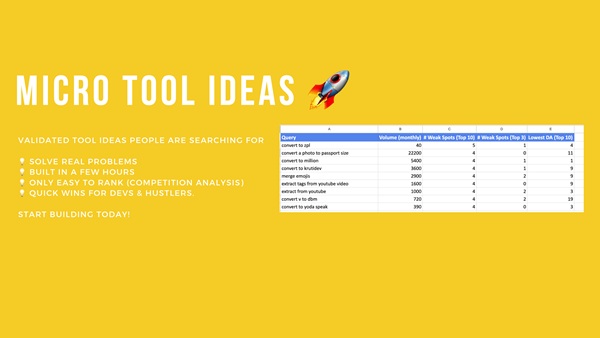No products in the cart.
[GroupBuy] Easy-to-Rank Micro-Tool Ideas You Can Build Fast – Paul P
$59.00 $37.00
- Payment method: I will send the payment link to your email.
- Deliver by: Google Drive, Mega.nz
Category: Marketing
This article delves into the world of Easy-to-Rank Micro-Tool Ideas You Can Build Fast, exploring strategies and insights derived from Paul P.‘s comprehensive guide. Discover how to identify underserved niches, leverage SEO for rapid ranking, and build valuable tools even with limited coding experience.
Table of Contents
Easy-to-Rank Micro-Tool Ideas You Can Build Fast
The allure of generating passive income and attracting consistent traffic online is undeniable. But, the digital landscape is saturated, making it challenging to break through the noise and establish a profitable online presence. Easy-to-Rank Micro-Tool Ideas You Can Build Fast offers a seemingly improbable solution: identify and create simple, specialized online tools that address specific user needs, capitalizing on proven search demand and weak competition. It presents a systematic way to quickly create functional micro-tools, drive traffic, and potentially generate revenue.
The Rise of the Micro-Tool Business
Micro-tools represent a paradigm shift in the online business model. They are not complex software suites or elaborate web applications. Instead, they are highly focused, single-purpose tools designed to solve a specific problem or fulfill a particular need. The beauty of this approach lies in its simplicity and speed of execution. The Easy-to-Rank Micro-Tool Ideas You Can Build Fast highlights these virtues, noting that many of these tools can be built in a few hours, leveraging no-code platforms or AI-assisted Integrated Development Environments (IDEs) such as Bolt, Lovable, and others. Think of an online image resizer, a simple text-to-speech converter, or even a basic unit conversion calculator. These are all examples of micro-tools that often require minimal development effort but can fulfill a tangible need for countless users. Some of these micro-tools gaining traction are extracttextfromimage.com (70,000 visits/month) and ai-midi.com/ (12,400 visits/month), demonstrating their potential for significant traffic.
The key to success in the micro-tool market is identifying the right problems to solve. You need to find underserved niches where users are actively searching for solutions, yet the existing competition is weak or lacking. This is where the Easy-to-Rank Micro-Tool Ideas You Can Build Fast resource truly shines, providing a comprehensive list of ideas vetted for both high search demand and low competition. The tools included in the guide are not just random suggestions thrown together. They represent a carefully curated selection that considers search volume, competition analysis, and the potential for rapid ranking in search engine results pages (SERPs). This data-driven approach removes the guesswork and helps aspiring entrepreneurs focus their efforts on areas most likely to yield positive results.
The rise of micro-tools also reflects the changing nature of online user behavior. Users are increasingly seeking quick, convenient solutions to specific problems. They don’t want to wade through complex applications or spend hours learning new software. They want a simple tool that can get the job done quickly and effectively. This shift in user expectations has created a fertile ground for micro-tools to thrive. By providing targeted solutions that are easily accessible and user-friendly, micro-tools can quickly become go-to resources for a wide range of users.
Identifying Low Competition, High Demand Opportunities
The cornerstone of the Easy-to-Rank Micro-Tool Ideas You Can Build Fast methodology lies in identifying opportunities where user demand is high and competition is weak. This targeted approach increases the likelihood of ranking well in search engine results and attracting significant organic traffic. The resource provides data-driven insights into search volume and competition levels for each tool idea, enabling users to make informed decisions about which niches to pursue.
The key concept here is “weak competition.” This refers to websites ranking in the top 10 search results that have low Domain Authority (DA) and lack overall authority. The course analysis also uses tools like lowfruits. io to identify these opportunities, alongside Search volume data for every tool idea and Weak competition breakdown. These sites are often poorly optimized, lack quality backlinks, and may offer a subpar user experience.
As a result, they are vulnerable to being outranked by newer, better-optimized websites. The Easy-to-Rank Micro-Tool Ideas You Can Build Fast course leverages this vulnerability by providing a list of tool ideas where weak websites dominate the search results. This gives aspiring micro-tool entrepreneurs a clear advantage, as they can focus their efforts on niches where they have a realistic chance of achieving top rankings.
Finding these golden opportunities requires a strategic approach to keyword research and competition analysis. Tools like Ahrefs, SEMrush, and Moz can be used to assess search volume, keyword difficulty, and the domain authority of competing websites. However, the Easy-to-Rank Micro-Tool Ideas You Can Build Fast resource simplifies this process by providing pre-vetted tool ideas and accompanying data. This saves users time and effort, allowing them to focus on building and promoting their micro-tools rather than spending countless hours on research.
The list comes with Search volume data for every tool idea and Weak competition breakdown. Additionally, the resource offers guidance on how to identify weak signals in search results, such as outdated content, poorly designed websites, and lack of social media presence. By combining these insights with traditional SEO techniques, entrepreneurs can significantly increase their chances of ranking well and attracting organic traffic to their micro-tools.
The Importance of an SEO-Centric Approach
The Easy-to-Rank Micro-Tool Ideas You Can Build Fast guide emphasizes the critical role of Search Engine Optimization (SEO) in achieving visibility and attracting users to your micro-tool. Without a solid SEO strategy, even the most innovative and valuable tool can languish in obscurity. The guide stresses the importance of SEO for tool visibility and includes Ranking Modules (added in April 2025). Thus, Paul P.‘s resource includes dedicated modules covering various aspects of SEO, from on-page optimization to link building.
One of the key SEO strategies recommended in the guide is the use of exact match domains (EMDs). An EMD is a domain name that precisely matches the primary keyword for your tool. For example, if you are building a tool that converts HTML to JSON, an EMD like htmltojson.com would be ideal. EMDs can provide a significant ranking boost, as they signal to search engines that your website is highly relevant to the target keyword. The guide recommends choosing a domain name that matches your tool’s primary keyword (e. g. , htmltojson. com). However, it’s important to note that EMDs are not a guaranteed recipe for success. Search engines have become more sophisticated in recent years and are less likely to reward websites that rely solely on EMDs for ranking. You still need to create high-quality content, build backlinks, and provide a positive user experience to achieve top rankings.
Another important SEO strategy is to focus on being very niche. The Easy-to-Rank Micro-Tool Ideas You Can Build Fast guide emphasizes the importance of targeting a specific audience or search intent. By focusing on a narrow niche, you can reduce competition and improve your chances of ranking well for relevant keywords. For example, instead of building a generic image editor, you could create a tool that specifically optimizes images for social media or e-commerce websites. This highly targeted approach can help you attract a loyal audience and establish yourself as an authority in your niche.
Therefore, a key action you can take is to focus on targeting a specific audience or search intent to reduce competition and improve ranking chances. The guide also stresses the importance of building backlinks, which are links from other websites to your own. Backlinks are a critical ranking factor, as they signal to search engines that your website is trustworthy and authoritative. The resource emphasizes the importance of acquiring high-quality backlinks from relevant websites in your niche. It helps you get links from other relevant websites to boost your authority and get in top 3 positions. It also provides a list of 30 high-authority websites for easy backlinks.
Paul P
Paul P., the creator of the Easy-to-Rank Micro-Tool Ideas You Can Build Fast, has crafted a resource designed to empower individuals to quickly launch and rank functional micro-tools. His approach combines meticulously curated lists of high-demand, low-competition ideas with practical SEO guidance. This combination aims to lower the barrier to entry for aspiring entrepreneurs. His experience and insights into the micro-tool market are woven throughout the product, guiding users towards quick wins in the digital landscape.
The Philosophy Behind the Easy-to-Rank Micro-Tool Ideas You Can Build Fast
The underlying philosophy behind Paul P.‘s Easy-to-Rank Micro-Tool Ideas You Can Build Fast is deceptively simple: identify a genuine need, craft a simple solution, optimize for search, and iterate based on user feedback. This philosophy stems from a deep understanding of the internet’s dynamic nature and the human desire for readily accessible, practical solutions. Paul understands that many people are searching for very specific tools and generators to solve everyday problems. He therefore created this invaluable list of micro-tool ideas, taking the difficult research out of the equation for his clients.
At its core, the Easy-to-Rank Micro-Tool Ideas You Can Build Fast philosophy also reflects a commitment to empowering individuals to take control of their online destiny. It challenges the notion that success online requires vast technical skills, huge capital investments, or years of grinding. Instead, it suggests that with the right knowledge and a focused approach, anyone can create valuable online assets that generate traffic and potential revenue. Paul P. recognizes that technical expertise can often be a barrier to entry. Therefore, the Easy-to-Rank Micro-Tool Ideas You Can Build Fast also stresses that many of these micro tool ideas can be created using no-code platforms or AI IDEs like Bolt, Lovable. It claims many tools are simple enough to build in just a few hours using AI.
The guide acknowledges that consistent effort is required to maintain and improve SEO rankings once a strong position has been attained. This involves continually monitoring website analytics, updating content to stay fresh and relevant, and aggressively building quality backlinks. While building high search engine rankings is key, the Easy-to-Rank Micro-Tool Ideas You Can Build Fast approach also emphasizes the importance of providing a great user experience. The guide emphasizes the Importance of user feedback for improvement and smoother experience that search engines will love. This includes having a user-friendly interface and fast and reliable performance, along with adding useful, relevant content to help users better utilize the tool.
Paul P.’s Approach to SEO and Ranking
One of the defining characteristics of Paul P.‘s approach to SEO is its emphasis on data-driven decision-making. He doesn’t rely on guesswork or outdated SEO tactics. Instead, he leverages data from various sources to identify the most promising opportunities and optimize his strategies. This involves thorough keyword research to identify high-volume, low-competition keywords, and analysis of competitor websites to understand their strengths and weaknesses. Paul P.‘s methodology utilizes tools like lowfruits. io to identify these opportunities.
Paul P. understands that search engine algorithms are constantly evolving; hence, his approach prioritizes adaptability and continuous learning. He stays abreast of the latest SEO trends and algorithm updates, and he encourages his students and followers to do the same. This proactive approach allows him to quickly adapt his strategies and maintain a competitive edge in the ever-changing digital landscape. The Easy-to-Rank Micro-Tool Ideas You Can Build Fast provides guidance on how to adapt to algorithm changes and maintain rankings over time.
This dedication to adaptability extends to the entire web development process, from the user interface design (UI) to the back-end infrastructure. A simple, intuitive UI is critical to ensuring that all visitors have a good experience when using your web app. By building a basic, easy-to-use UI, you invite visitors back to your site in the future. You can also ask for direct feedback on your website to learn how to best improve it for your users. This flexibility in implementation and design fosters a collaborative ecosystem of improvement where micro-tool entrepreneurs can share ideas, learn from each other’s successes and failures, and collectively push the boundaries of what’s possible with micro-tools.
Feasibility and Accessibility for Non-Developers
A notable aspect of Paul P.’s approach is its focus on making micro-tool development accessible to individuals without extensive coding knowledge. The Easy-to-Rank Micro-Tool Ideas You Can Build Fast explicitly states, Not necessarily! . . . many of these ideas can be created using no-code platforms or AI IDEs like Bolt, Lovable. This is achieved by advocating for the use of no-code platforms and AI-powered development tools that simplify the building process. These platforms enable users to create functional micro-tools with minimal coding required.
No-code platforms provide a visual interface for building applications, allowing users to drag and drop components, configure workflows, and connect to various data sources. This approach eliminates the need to write complex code, making it easier for non-developers to bring their ideas to life. Some popular no-code platforms include Bubble, Webflow, and Adalo. AI-powered development tools further accelerate the building process by automating repetitive tasks and providing intelligent suggestions. For example, AI can be used to generate code snippets, design user interfaces, and optimize website performance. These tools essentially serve as digital assistants, helping non-developers overcome technical hurdles and build high-quality micro-tools more efficiently.
One of the 650+ micro-tool ideas offered in the guide is the “AI + generator” tools. The list contains 200 ‘AI + generator’ tool ideas. As AI becomes increasingly relevant, these tool ideas can allow non-developers to utilize AI to serve customers online. Still, there are certain actions you can take to make micro-tool development feasible and accessible for non-developers. Using pre-built templates and libraries significantly reduces the amount of coding required. Many platforms offer templates for common types of micro-tools, such as calculators, converters, and form builders. These templates provide a basic structure that can be easily customized to suit specific needs. By leveraging these resources, non-developers can quickly create functional micro-tools without having to start from scratch. They can also partner with developers or designers. Non-developers can collaborate with freelancers or agencies to outsource specific tasks that require technical expertise.
Conclusion
The Easy-to-Rank Micro-Tool Ideas You Can Build Fast, carefully crafted by Paul P., presents a compelling and actionable strategy for individuals seeking to establish a profitable online presence. By focusing on high-demand, low-competition niches, and leveraging practical SEO techniques, the resource empowers individuals, even those with limited coding experience, to quickly launch and rank functional micro-tools, ultimately generating traffic and potential revenue. The emphasis on data-driven selection, actionable SEO steps, and accessibility for non-developers makes it a pragmatic roadmap to quick wins in the digital marketplace.
Sales Page:_https://paulpp.gumroad.com/l/500-tools
Delivery time: 12 -24hrs after paid
Be the first to review “[GroupBuy] Easy-to-Rank Micro-Tool Ideas You Can Build Fast – Paul P” Cancel reply
Related products
$19.00
$49.00
$20.99
$85.00












Reviews
There are no reviews yet.